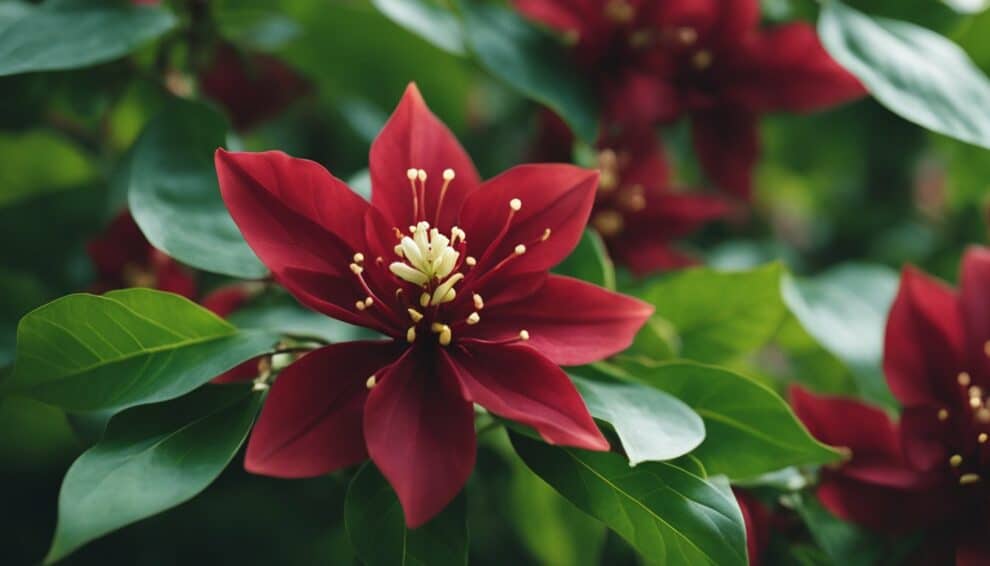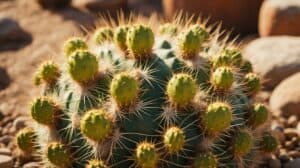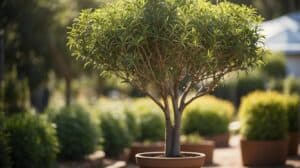Calycanthus Floridus, commonly known as the Sweetshrub, is a flowering plant native to the southeastern United States.
Known for its alluring fragrance and unique appearance, the Sweetshrub has long been a favorite among gardeners and nature enthusiasts alike.
Despite its popularity, however, the Sweetshrub remains somewhat of a mystery to many.

One of the most intriguing aspects of the Sweetshrub is its unusual flowers.
Unlike most flowering plants, which have petals arranged in a circular or spiral pattern, the Sweetshrub’s flowers are composed of numerous small, strap-like petals arranged in a star shape.
This distinctive appearance, combined with the plant’s sweet, spicy fragrance, has made it a favorite among those who appreciate unique and unusual flora.
Botanical Profile of Calycanthus Floridus
Taxonomy and Nomenclature
Calycanthus floridus, commonly known as sweetshrub or Carolina allspice, is a deciduous shrub belonging to the Calycanthaceae family.
The plant is native to the southeastern United States and is typically found in moist woodlands, along streams, and in low-lying areas.
The genus name Calycanthus is derived from the Greek words kalos, meaning beautiful, and anthos, meaning flower.
Physical Characteristics
The sweetshrub is a medium-sized shrub that can grow up to 10 feet tall and wide.
It has a multi-stemmed, upright growth habit and produces a dense, rounded crown.
The leaves are simple, opposite, and ovate to oblong in shape, measuring 3-6 inches long and 2-4 inches wide.
The foliage is dark green, glossy, and aromatic when crushed.
The most striking feature of the sweetshrub is its flowers, which bloom in late spring to early summer.
The flowers are solitary, terminal, and cup-shaped, measuring 1-2 inches in diameter.
The petals are maroon to reddish-brown in color and have a spicy, clove-like fragrance, which is why the plant is also called “Carolina allspice.”
Growth Habit
Calycanthus floridus is a slow-growing shrub that prefers moist, well-drained soils and partial shade.
It is tolerant of a wide range of soil types and can grow in both acidic and alkaline soils.
The plant is relatively low-maintenance and requires minimal pruning, except to remove dead or damaged wood.
Overall, the sweetshrub is an attractive and versatile plant that can be used in a variety of landscape settings.
Its unique fragrance and striking flowers make it a popular choice for gardens, borders, and naturalized areas.
Habitat and Distribution

Native Range
Calycanthus Floridus, commonly known as Sweetshrub, is a deciduous shrub that is native to the southeastern United States.
Its native range extends from Virginia to Florida, and west to Texas.
Habitat Preferences
Sweetshrub is commonly found in moist, well-drained soils in the understory of deciduous forests, along stream banks, and in wetlands.
It can also grow in drier upland sites, but prefers partial shade.
Sweetshrub is often found growing in association with other understory plants such as ferns, wildflowers, and other shrubs.
Sweetshrub is an adaptable plant that can tolerate a range of soil types, including clay, loam, and sand.
It can also tolerate acidic to slightly alkaline soils. However, it does not tolerate salt spray or drought conditions.
Overall, Sweetshrub is a relatively common plant within its native range, and can be found in a variety of habitats.
Its adaptability to different soil types and light conditions make it a valuable plant for landscaping and restoration projects.
Cultivation and Care

Planting Guidelines
Calycanthus floridus, commonly known as sweetshrub, is a hardy plant that thrives in USDA hardiness zones 5 to 9.
When planting sweetshrub, it’s important to choose a location that receives partial shade to full sun, as the plant prefers well-drained soil that is rich in organic matter.
Planting should be done in the spring or fall, when the soil is moist and temperatures are mild.
Dig a hole that is twice the size of the root ball and add compost or other organic matter to the soil.
Place the plant in the hole, backfill with soil, and water thoroughly.
Maintenance Tips
Sweetshrub requires minimal maintenance once established.
Regular watering is important during the first year after planting to ensure the plant establishes a strong root system.
After that, the plant can tolerate periods of drought.
Pruning should be done in late winter or early spring before new growth appears.
Remove any dead or damaged branches, and prune back any overgrown branches to maintain the plant’s shape.
Common Challenges
Sweetshrub is generally a low-maintenance plant, but it can be susceptible to a few pests and diseases.
Aphids and spider mites can be a problem, but can be controlled with insecticidal soap or horticultural oil.
Another issue that can arise is root rot, which can be caused by overwatering or poorly drained soil.
To prevent this, ensure that the soil is well-drained and avoid overwatering.
Overall, with proper care and attention, Calycanthus floridus can thrive in a variety of garden settings and add a touch of mystery and allure to any landscape.
Ecological and Cultural Significance

Role in the Ecosystem
Calycanthus floridus, commonly known as the sweetshrub, is a deciduous shrub that is native to the southeastern United States.
It typically grows in moist, well-drained soils in woodland areas, along streams, and in other areas with partial shade.
The sweetshrub is an important component of the local ecosystem, providing food and habitat for a variety of wildlife, including birds, butterflies, and other insects.
The plant’s flowers are particularly attractive to pollinators, making it an important species for maintaining biodiversity in the region.
Historical Uses
The sweetshrub has a long history of use by indigenous peoples and early settlers in the southeastern United States.
Native American tribes used the plant for a variety of medicinal purposes, including treating fevers, headaches, and other ailments.
Early settlers also recognized the plant’s medicinal properties and used it to treat a range of conditions.
In addition to its medicinal uses, the sweetshrub was also used for its fragrant flowers and attractive foliage, which were often used in perfumes and other cosmetic products.
Modern Ornamental Value
Today, the sweetshrub is primarily valued for its ornamental qualities.
The plant’s attractive flowers, which bloom in late spring and early summer, are a popular feature in many gardens and landscapes.
The plant’s foliage, which turns a vibrant yellow in the fall, also adds to its ornamental value.
The sweetshrub is a relatively low-maintenance plant that is well-suited to a variety of growing conditions, making it a popular choice for gardeners and landscapers alike.
Overall, the sweetshrub’s ecological and cultural significance make it a valuable addition to any garden or landscape.
Frequently Asked Questions

What are the ideal growing conditions for Sweetshrub?
Calycanthus floridus, commonly known as Sweetshrub or Carolina Allspice, prefers to grow in moist, well-drained soil with partial shade.
It can tolerate a wide range of soil types, including sandy, loamy, and clay soils.
Sweetshrub can also grow in full sun, but it may require more frequent watering in hot and dry climates.
How should I care for a Sweetshrub in my garden?
Sweetshrub is a low-maintenance plant that requires minimal care. Water it regularly, especially during hot and dry periods, to keep the soil moist.
Mulching around the base of the plant can help retain moisture and suppress weeds.
Fertilization is not necessary, but you can apply a slow-release fertilizer in the spring if desired.
Prune the plant after flowering to maintain its shape and health.
Can Sweetshrub thrive in different hardiness zones?
Sweetshrub is a hardy plant that can grow in USDA hardiness zones 5 to 9.
It can tolerate cold temperatures down to -10°F (-23°C) and hot temperatures up to 100°F (38°C).
However, it may require additional protection in extreme weather conditions.
What are the different varieties of Sweetshrub available?
There are several varieties of Sweetshrub available, including ‘Athens’, ‘Hartlage Wine’, and ‘Michael Lindsey’.
These varieties differ in their flower color, size, and fragrance.
‘Athens’ has white flowers with a lemony scent, while ‘Hartlage Wine’ has maroon flowers with a fruity scent.
‘Michael Lindsey’ has yellow flowers with a spicy scent.
What is the symbolism associated with Carolina Allspice?
Sweetshrub has a rich history of symbolism in Native American and early European cultures.
It was used for medicinal purposes, as well as in spiritual and ceremonial practices. The plant is associated with love, passion, and protection.
In modern times, Sweetshrub is often used in aromatherapy and perfumery.
How do I properly prune a Sweetshrub to maintain its shape and health?
Pruning Sweetshrub is simple and straightforward. After flowering, prune the plant to remove dead or damaged branches and to shape it as desired.
Avoid pruning more than a third of the plant at one time, as this can stress the plant and reduce its flowering.
Sweetshrub can also be pruned in the winter to rejuvenate the plant and promote new growth.














